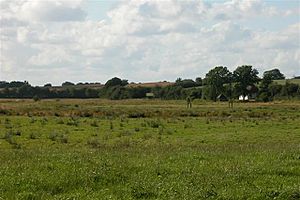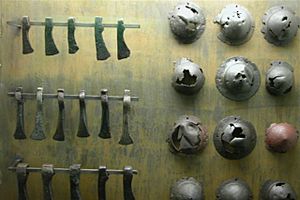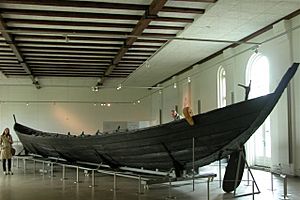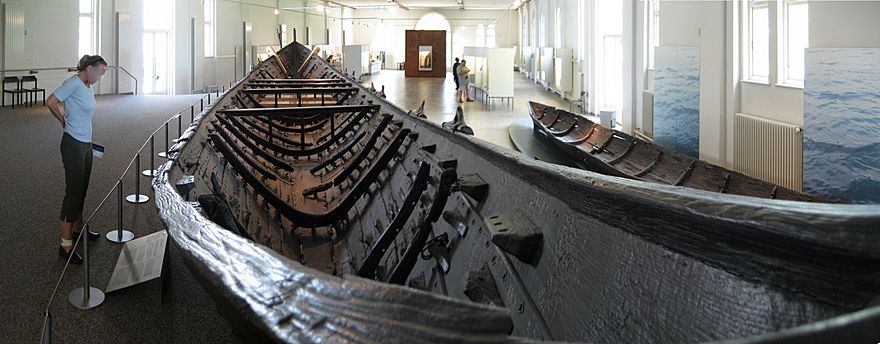Nydam Mose facts for kids
The Nydam Bog (also called Nydam Mose) is an amazing archaeological site in Denmark. It's found near the town of Øster Sottrup, about eight kilometers from Sønderborg. This bog holds many secrets from ancient times.
Contents
A Sacred Place in the Iron Age
Long ago, during the Nordic Iron Age, the Nydam Bog was a very special and sacred place. People would offer weapons and even ships here. They gave these items to their gods to thank them for winning battles.
Many of these items were broken on purpose. They were bent, smashed, or cut into pieces. This was part of a special ritual from around 200 to 400 CE.
The first discoveries from the bog happened in the 1830s. A local farmer found old swords and shields. He even gave them to his children to play with!
Three ancient boats were found in the Nydam Bog. One of them is a 23-meter-long oak boat. It's called "the Nydam Boat." This boat is very important because it's one of the oldest rowing vessels ever found in Northern Europe. Another boat, the Hjortspring boat, is even older.
Uncovering History: The Excavations
Archaeologists have worked hard to uncover the secrets of Nydam Bog. They have dug up many amazing things over the years.
First Dig: Conrad Engelhardt's Discoveries
From 1859 to 1863, an archaeologist named Conrad Engelhardt led the first big dig. He found many weapons, tools, and pieces of clothing. He also found two complete boats. One was made of oak, and the other was made of pine.
The weapons included lances, spears, bows, arrows, and round shields. Underneath these finds, parts of a third boat were found. It looked like this boat had been destroyed during the ancient sacrifice.
Engelhardt's work stopped suddenly in 1864. This was because of the Second Schleswig War. Sadly, some of the things found in the bog were lost during the war. The smaller pine boat, which was about 19 meters long, was even chopped up and used as firewood by soldiers.
Second Dig: New Finds from the National Museum
The National Museum of Denmark started digging at the bog again in 1989. Since then, they have found many more weapons. These include swords, spears, bows, and arrows. They also found personal items like belt buckles, brooches, and fancy clasps. These discoveries are from the Iron Age, dating from about 250 to 550 CE.
The Famous Nydam Boat
The Nydam Bog was likely used for sacrifices many times between 200 and 450 CE. Conrad Engelhardt found the famous Nydam Boat on August 17, 1863. This oak boat was the first and largest of the three boats found. It is also the only one still in good condition today. The pine boat was completely destroyed during the Second Schleswig War.
Scientists used a method called dendro dating to figure out the boat's age. They learned it was built around 310–320 CE. The Nydam Boat is 23 meters long and about 3.5 meters wide. It weighs over three tons! It had 14 pairs of oars and likely needed a crew of about 45 men.
After Denmark lost the war, the Nydam Boat was moved to Prussia. Today, you can see it on display at Gottorf Castle in Schleswig, Germany.
The Nydam Society
People in the local area have always been very interested in the Nydam Bog. The discoveries from Nydam are an important part of the history between Danish and German cultures. Because of this, the "Society for Nydam Research" was started in 1983. It is usually called the Nydam Society.
This group helped the National Museum of Denmark to start digging at the bog again. The Nydam Society also wanted to build a copy of the Nydam Boat. They finally did! The replica boat, called the Nydam Tveir, was built using the same old techniques. This helped them understand how large boats were made long ago.
Visiting Nydam Bog Today
Today, the Nydam Bog is a peaceful green meadow. You can park your car on Nydamvej. From there, a path called Nydamstien leads to a small white house, Nydamhuset. This house is right next to where the amazing discoveries were made. It takes about 10 minutes to walk there.
Images for kids
Panorama
See also
- Alu (runic)
- Weapons sacrifice
- Ship burial









